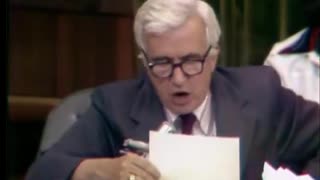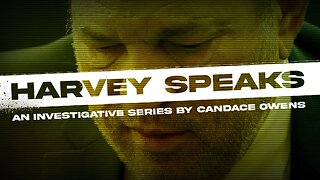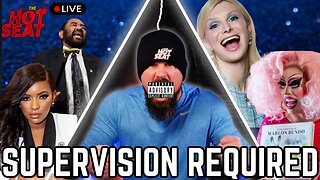Premium Only Content

Watergate Hearings Day 21: Richard Moore, Alexander Butterfield & Herbert W. Kalmbach (1973-07-16)
The dark side of history: https://thememoryhole.substack.com/
Alexander Porter Butterfield (born April 6, 1926) is a retired United States Air Force officer, public servant, and businessman. He served as the deputy assistant to President Richard Nixon from 1969 to 1973. He revealed the White House taping system's existence on July 13, 1973, during the Watergate investigation but had no other involvement in the scandal. From 1973 to 1975, he served as administrator of the Federal Aviation Administration.
Early life and Air Force career
Butterfield was born April 6, 1926, in Pensacola, Florida,[1] to Susan Armistead Alexander Butterfield and United States Navy pilot (later rear admiral) Horace B. Butterfield.[2] He grew up in Coronado, California, and left home in 1943.[3] Butterfield enrolled in college at the University of California, Los Angeles,[1] where he became a friend of H. R. Haldeman and John Ehrlichman.[4] He left the university to join the United States Air Force in 1948.[1][2][a]
Initially, Butterfield was stationed at Las Vegas Air Force Base (now Nellis Air Force Base) as a fighter-gunnery instructor before being transferred to the 86th Fighter Wing in Munich, West Germany, in November 1951, where he was a member of the Skyblazers [ja] jet fighter acrobatic team.[2][3] He later served as the operations officer of a fighter-interceptor squadron in Knoxville, Tennessee, before being promoted to commander of a fighter squadron at Kadena Air Base in Okinawa, Japan.[2] During the Vietnam War, Butterfield commanded a squadron of low and medium-level[5] combat tactical air reconnaissance aircraft.[2] He flew 98 combat missions[6] and was awarded the Distinguished Flying Cross.[1] In 1965 and 1966, Butterfield served as the military assistant to the special assistant to the Secretary of Defense,[7] where he became a friend of Alexander Haig.[8] He also gained extensive experience working at the White House, where he spent half his time.[8] He advanced to the rank of colonel and, beginning in 1967, was serving in Australia as the F-111 project officer; representative for the commander-in-chief of the Pacific forces; and senior U.S. military representative.[2][1][7]
During his military career, he attended the National War College,[2] and earned a bachelor of science degree from the University of Maryland (1956) and a master of science degree from George Washington University (1967).[7]
White House assistant
Watergate scandal
The Watergate complex in 2006
Events
List
People
Watergate burglars
Groups
CRP
White House
Richard Nixon Alexander Butterfield Charles Colson John Dean John Ehrlichman Gerald Ford H. R. Haldeman E. Howard Hunt Egil Krogh G. Gordon Liddy Gordon C. Strachan Rose Mary Woods
Judiciary
Journalists
Intelligence community
Congress
Related
vte
Obtaining a position
In late 1968, Butterfield learned that he would be stationed in Australia for another two years, delaying any potential promotion and potentially harming his military career.[9][10] The ambitious Butterfield wanted to be in "the smoke" (where the action was), and wanted to leave Australia.[11] After coming across a newspaper article which mentioned the appointment of H. R. Haldeman as Nixon's White House Chief of Staff, Butterfield wrote to Haldeman asking for a job.[9][10] The two met in New York City about December 19, 1968, to discuss a role as a military aide, but when nothing suitable came up, Butterfield asked to take any job in the White House. General Andrew Goodpaster, former White House staff secretary in the Eisenhower administration, suggested that Haldeman have a deputy, and Haldeman offered the position to Butterfield about January 13.[12] Butterfield retired from the Air Force a few days later,[6][b] and his appointment as deputy assistant to the president was announced on January 23, 1969.[14]
Role as deputy assistant
As deputy assistant to the president, Butterfield was Haldeman's chief assistant. His first few days in the White House were difficult. Butterfield did not meet the president for 13 days.[15] When Haldeman finally introduced Butterfield to Nixon, their meeting was short and awkward.[10][15] Haldeman then left for California, leaving Butterfield in charge of the White House staff for four days. During the second meeting with Butterfield, Nixon was rude and condescending,[10][15] and Butterfield nearly resigned. The following day, however, Nixon was cordial and witty, and Butterfield resolved to stay at the White House.[15] Butterfield, who came to like Nixon immensely, nevertheless felt the president was an "ignorant boor, a bumpkin".[11] Initially, when meeting with Nixon, Butterfield had to mimic Haldeman's mannerisms and to duplicate his managerial style. Everything Haldeman and Butterfield did was designed to make Nixon feel comfortable and relaxed, never surprised or "spooked". Haldeman told him, "If you don't do things exactly as I do, it could upset [Nixon]."[11]
Next to Haldeman, Butterfield was the most powerful aide in the White House. He met with Nixon and Haldeman every day at 2 P.M. to plan the following day's activities. He "completely controlled" what paperwork Nixon saw and logged memos. He accompanied Haldeman on all domestic trips, co-supervised traveling White House staff with Haldeman, and ran the White House when Haldeman and Nixon went on foreign trips. Every meeting the president attended required "talking points" for Nixon written by an appropriate staff person as well as an after-meeting summary by that person, and Butterfield oversaw the process by which both documents were completed and filed. Butterfield also oversaw all FBI investigations requested by the White House, which included routine background checks of potential employees as well as politically motivated investigations.[16] Other than Haldeman, no one had a more intimate knowledge of Nixon's working style, the daily operations of the White House, what Nixon may have read, or who Nixon may have met.[17]
Butterfield was also the person who primarily managed people as they met with Nixon. This included ensuring people arrived on time,[11] and that they did not stay too long. Butterfield also oversaw Nixon's often-distant relationship with his wife, Pat.[11][18] Late in 1970, the president's aides lost confidence in Constance C. Stuart, Pat Nixon's staff director and press secretary, and Butterfield was assigned responsibility for overseeing the First Lady's events and publicity.[19][20] The day after the 1972 presidential election, Pat Nixon confronted her husband over what she perceived to be Oval Office interference with her staff. Deputy assistant to the president Dwight Chapin and later Butterfield were appointed to act as liaison between the two staffs.[21]
Installing the taping system
Butterfield also oversaw installation of the taping system which Nixon ordered for the White House. On February 10, 1971,[11] Haldeman's assistant, Lawrence Higby, told Butterfield that Nixon wanted a voice-activated audio taping system installed in the Oval Office and on White House telephones.[22] The goal, Nixon said, was to create a more accurate record of events.[23] Butterfield worked with the Secret Service to install five hidden microphones in Nixon's desk in the Oval Office, two in lamps on the mantel over the fireplace, two in the cabinet room, and on all telephone lines in the Lincoln Sitting Room and Oval Office.[23] According to Butterfield, the system was highly secret, its existence known only to Nixon, Haldeman, Higby, and the three or four Secret Service technical staffers who installed it.[24][c] In April 1971, Nixon ordered the taping system to be installed in his private office in the Executive Office Building.[26]
Resignation
In March 1973, Butterfield was confirmed as administrator of the Federal Aviation Administration and resigned from his position at the White House.[27]
Revelation of the taping system
Speculation on its existence
John Dean testified in June 1973 that Nixon was deeply involved in the Watergate cover-up, and mentioned that he suspected White House conversations were taped.[28] Staff of the United States Senate Watergate Committee, thereafter, began to routinely ask witnesses appearing before the committee if they knew of any taping system.[17] Senate Watergate Committee staff then asked the White House for a list of dates on which the President had met with Dean.[29] About June 20 or 21,[30] Special White House Counsel for Watergate J. Fred Buzhardt provided the committee's Chief Minority (Republican) Counsel, Fred Thompson, with a document intended to impugn Dean's testimony. Buzhardt's document included almost verbatim quotations from meetings Nixon had with Dean.[29][d] Thompson initially violated an agreement under which the majority and minority staff would share all information. When committee Majority Investigator Scott Armstrong obtained the document, he realized it indicated the existence of a taping system.[32]
July 13 questioning
Tape recorder from President Nixon's Oval Office
Butterfield was questioned by Senate Watergate Committee staff Scott Armstrong, G. Eugene Boyce, Marianne Brazer, and Donald Sanders (deputy minority counsel) on Friday, July 13, 1973, in a background interview prior to his public testimony before the full committee.[33] Butterfield was brought before the committee because he was Haldeman's top deputy and was the only person other than Haldeman who knew as much about the president's day-to-day behavior.[4][e]
The critical line of questioning was conducted by Donald Sanders.[34] Armstrong had given a copy of Buzhardt's report to Butterfield;[35] now Sanders asked if the quotations in it might have come from notes. Butterfield said no, that the quotations were too detailed.[10] In addition, Butterfield said that neither staff nor the president kept notes of one-on-one private meetings with Nixon.[34] When asked where the quotations might have come from, Butterfield said he did not know.[10] Then Sanders asked if there was any validity to John Dean's hypothesis that the White House had taped conversations in the Oval Office. Butterfield replied, "I was wondering if someone would ask that. There is tape in the Oval Office."[34] Butterfield then told the investigators that, while he had hoped that no one would ask about the taping system, he had previously decided he would disclose its existence if asked a direct question.[36] Butterfield then testified extensively about when the taping system was installed and how it worked, telling the staff members, "Everything was taped... as long as the President was in attendance. There was not so much as a hint that something should not be taped."[37] Butterfield later said that he assumed the committee knew about the taping system, since they had already interviewed Haldeman and Higby.[38]
All present recognized the significance of this disclosure, and, as former political adviser to President Gerald Ford James M. Cannon put it, "Watergate was transformed".[39] Butterfield's testimony lasted from 2 PM to 6:30 PM. The four investigators swore themselves to secrecy and agreed to tell only the Chief Counsel and Chief Minority Counsel to the Senate Watergate Committee.[36] Chief Counsel Samuel Dash says he immediately informed his subordinate, Deputy Chief Counsel Rufus L. Edmisten, and then Democratic Senator Sam Ervin, chairman of the committee.[40] Both Ervin and Dash realized how important it was politically to have had a Republican uncover the taping system.[41] That same night, Ervin asked Dash to have Butterfield testify on Monday, July 16.[40]
July 16 questioning
Left to right: Fred Thompson, Sen. Howard Baker, and Sen. Sam Ervin during the Senate Watergate Committee hearings
Friday night, Thompson informed Senator Howard Baker, the ranking minority member on the Senate Watergate Committee, of Butterfield's admission.[40] After Ervin had told him the news as well, Baker began pushing to have Butterfield testify immediately.[42] Again breaking rules not to have private conversations or meetings with the White House, Thompson also informed Buzhardt about Butterfield's Friday night interview.[43]
Butterfield, scheduled to fly to Moscow on July 17 for a trade meeting, was worried that he would be called to testify before the Senate Watergate Committee and that this would force him to cancel his Russia trip.[42]
Sources vary as to the next sequence of events. According to some sources, Butterfield was notified on the morning of Sunday, July 15, that he would testify the next day. Butterfield then met with Baker (whom he knew slightly). Butterfield asked Baker to use his influence to cancel the testimony, but Baker declined. Butterfield then called the White House and left a message for Special Counsel Leonard Garment (Dean's replacement), advising him of the content of his Friday testimony and the committee's subpoena for him to testify on Monday.[f] Haig and Buzhardt[g] received Butterfield's message, and waited for Garment to return from a cross-country trip later that day. After Garment was informed, the White House staff did nothing. Butterfield was not contacted, and Nixon was not told about Butterfield's testimony until either Monday morning or late Monday afternoon.[45] According to Butterfield and other sources, Butterfield left a message about his Friday interview for Garment at the White House on Saturday night.[46] He then met with Baker Sunday morning, but Baker told him the chances were slim that he would be called to testify.[42] According to Butterfield, he did not learn that he was going to testify before the Ervin committee until shortly after 10 AM on Monday, July 16,[47] just about three hours before he was due to appear at 2 PM.[11][48][38]
Butterfield's July 16 testimony, which lasted just 30 minutes,[44] was carried on live television by all the major broadcast networks.[49] Senator Baker informed Dash before the hearing began that, since a Republican (Sanders) had elicited the testimony from Butterfield on July 13, he wanted Republican Chief Minority Counsel Thompson to question Butterfield during the hearing. Baker did not want the Republicans to look as if they had been caught by surprise.[50] The New York Times called Butterfield's testimony "dramatic",[49] and historian William Doyle has noted that it "electrified Washington and triggered a constitutional crisis".[51] Political scientist Keith W. Olson said Butterfield's testimony "fundamentally altered the entire Watergate investigation."[52]
Within hours of Butterfield's testimony, Haig had the taping system removed.[53]
Post-Watergate
Butterfield at the Lyndon B. Johnson Presidential Library in 2016
Watergate revelations
Butterfield was not involved in the Watergate cover-up and was never charged with any crime.[10]
Butterfield did, however, play a minor role in Watergate. Nixon had $1.6 million in campaign funds left over from the 1968 election. Determined to raise as much re-election money as he could before a new federal campaign finance law took effect on April 7, 1972, Nixon's staff and political operatives began raising large amounts of cash.[54] Some of this cash was used for illegal purposes connected with the Watergate scandal, such as surveillance and paying for the Watergate burglary. Haldeman retained $350,000 in cash in a locked briefcase in the office of Hugh W. Sloan Jr. at the Committee for the Re-Election of the President. Haldeman said the case, colloquially known as "the 350", was for polling operations. Haldeman aide Gordon C. Strachan moved the cash to the White House in April 1972, but Haldeman ordered it removed.[55] Strachan then asked Butterfield to handle the cash by giving it to someone Butterfield trusted.[56] On April 7,[57] Butterfield removed the cash and met a close friend at the Key Bridge Marriott in Rosslyn, Virginia. The friend agreed to keep the cash in a safe deposit box in Arlington County, Virginia, and make it available to the White House on demand.[56] Butterfield voluntarily revealed his role in "the 350" to United States Attorneys shortly after leaving the White House in March 1973.[17][h]
Butterfield also played a very limited role in some of the surveillance conducted by the Nixon White House. On September 7, 1972, Nixon met with Haldeman and Ehrlichman to discuss Senator Edward M. Kennedy's request for Secret Service protection while he campaigned on behalf of the Democratic presidential nominee, Senator George McGovern. Haldeman suggested Butterfield handle the details, and Butterfield, Ehrlichman, and Haldeman met with Nixon later that day to discuss planting a mole.[59] Nixon was convinced Kennedy was an adulterer, and wanted to catch him "in the sack with one of his babes". Butterfield assigned former Nixon bodyguard Robert Newbrand as the spy in Kennedy's protective detail on September 8.[60]
Federal Aviation Administration
By late 1972, Butterfield felt his job no longer challenged him, and he informally told President Nixon that he wanted to leave. Nixon offered him a position in the State Department, but Butterfield was not interested in it. Nixon then suggested the Federal Aviation Administration, and Butterfield agreed.[17]
On December 19, 1972, President Nixon nominated Butterfield to be the new Administrator of the Federal Aviation Administration.[61] Federal law, however, required that the Administrator be a civilian, not an active-duty or retired military officer. President Nixon sought legislation to waive this requirement for Butterfield, but it was not forthcoming. Subsequently, in February 1973 Butterfield resigned from the Air Force Reserves, giving up a $10,000 a year pension.[62] President Nixon withdrew Butterfield's nomination on February 26, 1973, and resubmitted it to the Senate the same day.[63] Butterfield was confirmed on March 12, 1973,[64] and he resigned as Deputy Assistant to the President on March 14.[16]
United States Secretary of Transportation Claude Brinegar often criticized Butterfield for being lax on aviation safety, allegations Butterfield strongly denied.[65] In early January 1975, President Gerald Ford asked for the resignation of all executive branch officeholders who had been prominent in the Nixon administration. The Washington Post, quoting anonymous White House sources, said Butterfield's dismissal was not retaliation for his role in revealing the White House taping system, and allowed Butterfield to make a case for keeping his job with new White House Chief of Staff Donald Rumsfeld.[65]
Butterfield did not retain his position, although the White House allowed him to take several months before resigning.[65] Butterfield resigned on March 25, 1975,[66] and left the government on March 31, 1975.[1]
Post-government career
Butterfield struggled for two years to find employment after leaving the federal government.[11] He eventually worked for a flight service company in San Francisco, California. He then found work with a financial holding company in Los Angeles. Butterfield left the financial industry to start a business and productivity consulting firm, Armistead & Alexander.[10] He retired in 1995.[67]
Butterfield was among those who correctly guessed the identity of Watergate informant "Deep Throat" prior to the disclosure in 2005. He told the Hartford Courant in 1995, "I think it was a guy named Mark Felt."[68]
Butterfield is a major source for Bob Woodward's 2015 book The Last of the President's Men.[6][10] Butterfield retained an extensive number of records when he left the White House, some of them historically important, including the "zilch" memo, which helped form part of the basis for the book.[11]
On July 11, 2022, Butterfield was a guest on Lawrence O'Donnell's MSNBC show, The Last Word.[69]
Cassidy Hutchinson, former aide in the Trump administration, testified to the January 6 Committee that she drew on Butterfield’s experience and example when deciding to go back to the Committee to testify fully and truthfully, despite significant legal and political pressure from Trump world.[70][71]
Personal life
Butterfield married Charlotte Maguire in 1949.[1] They divorced in 1985.[2]
Butterfield moved to La Jolla, California, in 1992, where he was a close friend of (and sometimes dated)[11] Audrey Geisel, the widow of Theodor Geisel (the author of children's books, known as "Dr. Seuss").[10] He returned to school, obtaining a master's degree in history from the University of California, San Diego. As of November 2015, he was working on a Ph.D. in history, with a focus on the presidential power to pardon. He remains active on the boards of directors of several corporations.[10]
References
Notes
Contrary to published reports, Butterfield did not serve in World War II.[3]
Contrary to some published reports, Butterfield himself denies that he was told to resign from the military before taking the position. He says his decision to retire was solely his own.[13]
Woodward and Bernstein note that the existence of the taping system was also known to White House Press Secretary Ron Ziegler and to Stephen B. Bull, Special Assistant to the President and Appointments Secretary and Butterfield's successor.[25]
In late April 1973, Nixon asked Haldeman to review the tapes of Nixon's meetings with John Dean on Watergate, with a view of finding any discrepancies which might undermine Dean's credibility. The morning of June 4, Nixon began reviewing these tapes and making almost verbatim notes about conversations. That evening, he met with Buzhardt. Nixon verbally recounted the notes he made, adding his interpretation or explanatory observations, as Buzhardt took notes. The President instructed Buzhardt to work the notes up into a document, and to give the document only to Thompson.[31]
Reporter Aaron Latham argues it is not clear why Butterfield was called. Bob Woodward and Carl Bernstein, he says, believe that Butterfield was called to testify because they had repeatedly suggested it to Armstrong. But Armstrong says neither the majority counsel nor minority counsel was interested. Senate Watergate Committee chief counsel Samuel Dash said that Butterfield was simply one of many Nixon aides the committee was getting around to interviewing. Assistant chief counsel James Hamilton, who authorized the interview with Butterfield, had done so because of revelations that Butterfield had handled "the 350" ($350,000 in cash held by the Nixon reelection committee). But since this issue was not considered critically important, Butterfield's interview had been put off several times.[33]
Samuel Dash also says Butterfield contacted the White House on Sunday.[40]
Fred Emery says it was Haig and Ziegler.[44]
Butterfield handled the money twice more. On April 21, 1972, he was told by Strachan to have $22,000 of the money delivered to Joseph Baroody, leader of the National Association of Arab Americans and a member of the Baroody family (which were very influential in conservative political circles). Butterfield contacted his friend, who delivered the money the next day. On November 28, 1972, Butterfield was instructed to obtain the money from his friend and turn it over to Strachan. This was the last transaction Butterfield was involved in.[58]
Citations
Hall 2008, p. 34.
The International Who's Who, 1997-98 1997, p. 232.
Alexander Butterfield Interview, Nixon Library 2008, p. 1.
Kutler 1992, pp. 367–368.
"Alexander Butterfield: "Evening With"". Lyndon B. Johnson Presidential Library. 2005. Archived from the original on September 14, 2016. Retrieved July 13, 2016.
Woodward 2015, p. 5.
"Alexander P. Butterfield. Collections: Textual Materials: White House Special Files: Textual Materials". Nixon Presidential Library and Museum. Archived from the original on June 24, 2016. Retrieved July 13, 2016.
Alexander Butterfield Interview, Nixon Library 2008, p. 5.
Alexander Butterfield Interview, Nixon Library 2008, pp. 3–4.
Wilkens, John (November 28, 2015). "Nixon Tapes and the Man Who Spilled". San Diego Tribune. Retrieved July 12, 2016.
Roig-Franzia, Manuel (October 12, 2015). "The Man Who Knew Too Much About Richard Nixon". The Washington Post. Retrieved July 12, 2016.
Alexander Butterfield Interview, Nixon Library 2008, pp. 3–5.
Alexander Butterfield Interview, Nixon Library 2008, p. 6.
Rugaber, Walter (January 24, 1969). "Nixon Names Aide to Help Oversee Domestic Affairs". The New York Times. pp. 1, 15.
Alexander Butterfield Interview, Nixon Library 2008, pp. 6–10.
Kutler 1992, p. 367.
Kutler 1992, p. 368.
Swift 2014, p. 253.
Beasley 2005, p. 119.
Troy 2000, pp. 189, 193.
Swift 2014, p. 264-265.
Butterfield 1974, pp. 45=46.
Brinkley & Nichter 2014, p. x.
Butterfield 1974, pp. 45–46.
Woodward & Bernstein 1976, p. 43.
Brinkley & Nichter 2014, p. xi.
Woodward 2015, p. 142.
Kutler 1992, p. 359.
Latham 1974, p. 46.
Dean 2015, p. 616.
Woodward & Bernstein 1976, pp. 43–51.
Woodward 2015, pp. 147–153.
Latham 1974, pp. 44–45.
Latham 1974, p. 60.
Latham 1974, p. 45.
Latham 1974, p. 63.
Kutler 1997, p. 638.
Emery 1995, p. 369.
Cannon 2013, p. 120.
Dash 1976, p. 180.
Emery 1995, p. 367.
Alexander Butterfield Interview, Nixon Library 2008, p. 46.
Woodward & Bernstein 1976, p. 57.
Emery 1995, p. 368.
Locker 2016, pp. 243–244.
Alexander Butterfield Interview, Nixon Library 2008, p. 48.
Alexander Butterfield Interview, Nixon Library 2008, pp. 46–47.
Alexander Butterfield Interview, Nixon Library 2008, p. 47.
Naughton, James M. (July 17, 1973). "Nixon Wired His Phone, Offices to Record All Conversation". The New York Times. pp. 1, 26.
Dash 1976, p. 182.
Doyle 1999, p. 183.
Olson 2014, p. 325.
Brinkley & Nichter 2014, p. xiii.
Emery 1995, pp. 108–109.
Emery 1995, p. 109.
Emery 1995, pp. 109–110.
Butterfield 1974, p. 53-54.
Butterfield 1974, p. 54-55.
Kutler 1997, pp. 132–133.
Fulsom 2012, pp. 104–105.
Charlton, Linda (December 20, 1972). "Nixon Appoints Aide for Liaison". The New York Times. p. 10.
Apple, R.W. Jr. (February 27, 1973). "Nominee to FAA Quits Air Force". The New York Times. p. 22.
"Butterfield Gets 2d Nomination". The Washington Post. February 27, 1973. p. D8.
Kraus 2008, p. 45.
Cannon, Lou (January 7, 1975). "Ford Said To Ask FAA Chief to Quit". The Washington Post. p. A1.
"Butterfield Quits as FAA Chief: Disclosed Existence of Nixon Tapes". The Washington Post. March 26, 1975. p. A2.
Woodward 2015, pp. 179–181.
Rizzo, Frank (December 17, 1995). "Nixon: One Role Will Remain Nameless". Hartford Courant. Retrieved July 12, 2016.
The Last Word with Lawrence O'Donnell/MSNBC Alexander Butterfield Was 'Worried To Death' Testifying Against Nixon, retrieved December 23, 2022
"To defy Trump world, transcript shows Cassidy Hutchinson draw courage from history". MSNBC.com. Retrieved December 23, 2022.
"Cassidy Hutchinson's Trump-supporting father refused to help her get her own lawyer for Jan 6 evidence". www.yahoo.com. December 22, 2022. Retrieved December 23, 2022.
Bibliography
Wikimedia Commons has media related to Alexander Butterfield.
Alexander Butterfield Interview Transcription. Document 2008-06-12-BUT (PDF) (Report). Nixon Presidential Library and Museum. June 12, 2008. Archived from the original (PDF) on July 29, 2016. Retrieved July 13, 2016.
Beasley, Maurine Hoffman (2005). First Ladies and the Press: The Unfinished Partnership of the Media Age. Evanston, Ill.: Northwestern University Press. ISBN 9780810123120.
Brinkley, Douglas; Nichter, Luke (2014). The Nixon Tapes: 1971–1972. Boston: Houghton Mifflin Harcourt. ISBN 9780544274150.
Butterfield, Alexander (1974). "Testimony of Alexander Porter Butterfield". Testimony of Witnesses: Alexander Butterfield, Paul O'Brien, and Fred C. LaRue. Book I. U.S. House of Representatives. 93d Cong., 2d sess. Washington, D.C.: U.S. Government Printing Office. hdl:2027/uiug.30112104083214.
Cannon, James M. (2013). Gerald R. Ford: An Honorable Life. Ann Arbor, Mich.: University of Michigan Press. ISBN 9780472116041.
Dash, Samuel (1976). Chief Counsel: Inside the Erwin Committee: The Untold Story of Watergate. New York: Random House.
Dean, John W. (2015). The Nixon Defense: What He Knew and When He Knew It. New York: Penguin Books. ISBN 9780143127383.
Doyle, William (1999). Inside the Oval Office: The White House Tapes From FDR to Clinton. New York: Kodansha International. ISBN 9781568362854.
Emery, Fred (1995). Watergate: The Corruption of American Politics and the Fall of Richard Nixon. New York: Simon & Schuster. ISBN 9780684813233.
Fulsom, Don (2012). Nixon's Darkest Secrets: The Inside Story of America's Most Troubled President. New York: Thomas Dunne Books. ISBN 9780312662967.
Hall, Mitchell K. (2008). Historical Dictionary of the Nixon-Ford Era. Lanham, Md.: Scarecrow Press. ISBN 9780810864108.
The International Who's Who, 1997–98. London: Europa Publications. 1997. ISBN 9781857430226.
Kraus, Theresa L. (2008). The Federal Aviation Administration: A Historical Perspective, 1903–2008. Washington, D.C.: Aviation Administration.
Kutler, Stanley I. (1992). The Wars of Watergate: The Last Crisis of Richard Nixon. New York: W.W. Norton. ISBN 9780393308273.
Kutler, Stanley I. (1997). Abuse of Power: The New Nixon Tapes. New York: Simon and Schuster. ISBN 9780684851877.
Latham, Aaron (June 17, 1974). "There is tape in the Oval Office". New York Magazine. pp. 44–46, 60, 63. Retrieved July 13, 2016.
Locker, Ray (2016). Nixon's Gamble: How a President's Own Secret Government Destroyed His Administration. Guilford, Conn.: Lyons Press. ISBN 9781493009312.
Olson, Keith (2014). "A President Resigns: The Watergate Scandal". In Angerholzer, Maxmillian (ed.). Triumphs and Tragedies of the Modern Congress: Case Studies in Legislative Leadership. Santa Barbara, Calif.: Praeger. ISBN 9781440831997.
Swift, Will (2014). Pat and Dick: The Nixons, an Intimate Portrait of a Marriage. New York: Threshold Editions. ISBN 9781451676945.
Troy, Gil (2000). Mr. and Mrs. President: From the Trumans to the Clintons. Lawrence, Kan.: University Press of Kansas. ISBN 9780700610341.
Woodward, Bob (2015). The Last of the President's Men. New York: Simon & Schuster. ISBN 9781501116445.
Woodward, Bob; Bernstein, Carl (1976). The Final Days. New York: Simon & Schuster. ISBN 9780671222987.
Government offices
Preceded by
John H. Schaffer
Administrator of the Federal Aviation Administration
1973–1975 Succeeded by
John L. McLucas
Authority control databases Edit this at Wikidata
Categories:
1926 birthsLiving peopleAdministrators of the Federal Aviation AdministrationCalifornia RepublicansFord administration personnelGeorge Washington University alumniMilitary personnel from CaliforniaMilitary personnel from FloridaNational War College alumniNixon administration personnelNixon administration personnel involved in the Watergate scandalPeople from Coronado, CaliforniaPeople from La Jolla, San DiegoPeople from Pensacola, FloridaRecipients of the Distinguished Flying Cross (United States)United States Air Force colonelsUnited States Air Force personnel of the Vietnam WarUniversity of California, San Diego alumniUniversity of Maryland, College Park alumni
Herbert Warren Kalmbach (October 19, 1921 – September 15, 2017) was an American attorney and banker. He served as the personal attorney to United States President Richard Nixon (1968–1973). He became embroiled in the Watergate scandal due to his fundraising activities in the early 1970s, some of which supported undercover operatives directed by senior White House figures under Nixon. Kalmbach was convicted and served 191 days in jail for his part in the scandal, and lost his license to practice law for a time, although he was later reinstated.[1]
Education, early career
Kalmbach was born on October 19, 1921, in Port Huron, Michigan.[1] He earned both his undergraduate and law degrees at the University of Southern California, and was admitted to the bar in 1952. He was a real estate lawyer and founding partner of Kalmbach, DeMarco, Knapp & Chillingworth.[2][3]
Meets Nixon, political fundraiser
Kalmbach was introduced to Richard Nixon, then vice-president, by H. R. Haldeman in the 1950s.[4] He raised money for Richard Nixon's candidacy in the 1960 United States presidential election and again in the 1968 United States presidential election.
Banker, becomes Nixon's attorney
Kalmbach declined Nixon's offer to appoint him Under Secretary of Commerce, choosing instead to remain in California and build up his law practice, becoming the former Vice President's private lawyer. His law firm prospered during this period; it employed two lawyers in 1968, 14 in 1970, and 24 by 1973. The presidential connection drew United Airlines, Dart Industries, Marriott Corporation, and MCA Inc. as clients. During this period Kalmbach founded the Bank of Newport, in Newport Beach, California. The firm performed routine legal chores for the President.
It was a shrewd choice. Kalmbach's solid but unspectacular career as a real estate lawyer was quickly touched with gold. Suddenly major clients from all over the nation were eager to sign up with the attorney who represented the President: United Air Lines, Dart Industries Inc., the Marriott Corp., MCA Inc. (the dominant producer of prime-time TV shows). National companies traditionally seek out lawyers who have friends and clients in high places in Washington, and Kalmbach's were very high indeed.[3][5]
Arranges private polling
Kalmbach was involved in a secret Nixon polling operation hidden from all but his closest senior advisors. Nixon used the poll results to shape policy and campaign strategy and manipulate popular opinion. On December 21, 1971, Kalmbach set up a Delaware shell corporation with private funding, to hide Administration sponsorship of polls.[6]
Joins 1972 re-election campaign
Kalmbach was also the Deputy Finance Chairman for the Committee to Re-elect the President. In this capacity he was eventually implicated in a fund-raising scandal involving re-election campaign contributions by Associated Milk Producers, Inc. (AMPI) and two other major dairy-farm cooperatives in connection with Nixon's support of an increase in price supports for milk in 1971.[7] Testimony by AMPI general manager George L. Mehrens in 1973 identified Kalmbach as a major solicitor of these contributions.[7] Articles on Charles Colson's involvement in the AMPI scandal indicated that $2 million in contributions had been expected, but that the actual donations were nearer to $400,000, of which some $197,500 had been given by AMPI.[7]
Manages finances for undercover operations
Kalmbach handled a secret $500,000 fund to finance the sabotage and espionage operations of Donald Segretti.[8][9]
Convicted, imprisoned
Kalmbach was associate finance chairman of the 1968 Nixon for President campaign and was an unofficial fund-raiser for the Committee for the Re-election of the President, controlling several secret funds. Kalmbach served six months in jail and was fined $10,000 for operating an illegal campaign committee and for offering an ambassadorship in return for political support. He also handled a secret $500,000 fund to finance sabotage and espionage operations in the salary of Donald H. Segretti, a lawyer, whose job it was to discredit the Democrats. including $30,000 to $40,000 in 1972 alone for spying on Democrats.[10] Segretti was paid from re-election funds gathered before the April 7, 1972, cutoff point after which a new law required full disclosure of contributors;[11] Kalmbach told investigators in early 1973 that he had destroyed the contribution records prior to the April 7 date, violating the Federal Corrupt Practices Act, which required the records be maintained for two years and which expired only as of the new law's going into effect.[12] Kalmbach claimed in a later FBI interview that he had not known who was supervising Segretti nor what activities he was being paid to perform.[11][13] Kalmbach also raised $220,000 in "hush money" to pay off the Watergate burglars. He claimed that he was told the money was for lawyer's fees; a claim he accepted because he felt the burglars wrongly believed that they were acting on authority.[14][15]
But it was his raising of $3.9 million for a secret Republican congressional campaign committee[16] and promising an ambassador a better post in exchange for $100,000 that led to his conviction and imprisonment for 191 days and a $10,000 fine.[17] Kalmbach pleaded guilty on February 25, 1974, on one count of violation of the Federal Corrupt Practices Act and on one count of promising federal employment as a reward for political activity and support of a candidate. He was sentenced to serve 6 to 18 months in prison for the first count and 6 months in prison on the second count. He executed both sentences concurrently and was released from prison on January 5, 1975.[18] Kalmbach lost his license to practice law, although he was reinstated in 1977.[15][19]
Later life
Although he retired in the late 1980s, he remained of counsel to Baker Hostetler.[3][9] He died on September 15, 2017, in Newport Beach, California.[1]
Notes
"Herbert Kalmbach, Who Figured in Watergate Payoffs, Dies at 95". New York Times. September 29, 2017.
"Herbert Warren Kalmbach." Almanac of Famous People, 9th ed. Thomson Gale, 2007. Reproduced in Biography Resource Center. Farmington Hills, Michigan: Gale, 2009. http://galenet.galegroup.com/servlet/BioRC. Fee via Fairfax County Public Library, accessed 2009-04-24.
"Baker Hostetler - Find Lawyers - Herbert W. Kalmbach". Costa Mesa, California: Baker Hostetler (law firm). Archived from the original on 2011-03-13. Retrieved 2009-04-24. "Herbert W. Kalmbach is Of Counsel to the firm. He has been involved in consulting assignments for a wide variety of clients."
All the President's Men, by Carl Bernstein and Bob Woodward, New York, 1974, Simon & Schuster
"The Rise and Fall of Herb Kalmbach". Time. March 11, 1974. "Discreet and studiously low-key, Herbert W. Kalmbach, 52, was the ideal lawyer to handle Richard Nixon's personal affairs. Like the President, he was a self-made and extraordinarily diligent man, both traits that Nixon admired in an aide. Above all else, Kalmbach was an unswerving and unquestioning loyalist."
Mike Mokrzycki. "Nixon Aides Ran A Covert Polling Operation," Los Angeles Times (AP), August 13, 1995; summarizing The Rise of Presidential Polling: The Nixon White House in Historical Perspective, Lawrence R. Jacobs and Robert Y. Shapiro, The Public Opinion Quarterly, Vol. 59, No. 2 (Summer, 1995), pp. 163-195 (article consists of 33 pages), Published by: Oxford University Press on behalf of the American Association for Public Opinion Research, Stable URL: https://www.jstor.org/stable/2749700
New York Times News Service. "Nixon's lawyer listed as solicitor," The Dallas Morning News, January 11, 1973, page 5A.
United Press International. "A Watergate chronology," The Dallas Morning News, April 29, 1973, page 44A.
de Witt, Karen (June 15, 1992). "Watergate, Then And Now. Who Was Who in the Cover-Up and Uncovering of Watergate". New York Times. Retrieved 2009-04-24. "Herbert W. Kalmbach Nixon lawyer"
United Press International. "Payment reported," The Dallas Morning News, March 8, 1973, page 2A.
United Press International. "Chapin, Segretti face grand jury," The Dallas Morning News, April 12, 1973, page 10A.
Seymour M. Hersh, New York Times News Service. "Donor list reported destroyed," The Dallas Morning News, May 4, 1973, page 1A.
New York Times Press Service. "Watergate jogs memory: Democrats recall strange election incidents," The Dallas Morning News, May 13, 1973, page 14A.
Larry Eichel. "The 'duality' that made the man: Richard Milhous Nixon, 1913-1994," Philadelphia Inquirer, April 24, 1994.
"Watergate figures! Where are they? What do they say?", Associated Press, June 14, 1982.
James R. Polk. "Top money manager: unpublicized fund-raiser may hold key for Nixon," originally in Washington Star, reprinted in The Dallas Morning News, February 3, 1972, page 2A.
Miller and Morris, "Donations flood a loophole," Los Angeles Times, October 11, 1992.
Stanley Kutler (ed.), Watergate: the fall of Richard Nixon, (Oxford: Blackwell Publishing, 2010), pp. 215-216
"The lives they lead now," Washington Post, June 13, 1982.
Further reading
Biography Index. A cumulative index to biographical material in books and magazines. Volume 10: September, 1973-August, 1976. New York: H. W. Wilson Co., 1977.
Biography Index. A cumulative index to biographical material in books and magazines. Volume 12: September, 1979-August, 1982. New York: H. W. Wilson Co., 1983.
Who's Who in America. 38th edition, 1974–1975. Wilmette: Marquis Who's Who, 1974.
Who's Who in America. 39th edition, 1976–1977. Wilmette: Marquis Who's Who, 1976.
Who's Who in the West. 14th edition, 1974–1975. Wilmette: Marquis Who's Who, 1974.
Select Committee on Presidential Campaign Activities (AKA Senate Watergate Hearings), 1973. Testimony given to the committee and cross-examination by senators and counsel. Can be found on YouTube.
Authority control databases Edit this at Wikidata
NARA
Categories:
1921 births2017 deathsAmerican male criminalsCalifornia lawyersCalifornia RepublicansLawyers disbarred in the Watergate scandalMembers of the Committee for the Re-Election of the PresidentPeople associated with BakerHostetlerPeople convicted in the Watergate scandalPeople from Port Huron, MichiganUSC Gould School of Law alumniUniversity of Southern California alumni
-
 3:50:14
3:50:14
The Memory Hole
2 months agoNixon Impeachment Hearings Day 2 (1974-07-24)
751 -
 54:18
54:18
Candace Show Podcast
10 hours agoHarvey Speaks: Jessica Mann & The Five Year Affair | Ep 3
170K83 -
 56:53
56:53
Grant Stinchfield
8 hours ago $6.90 earnedFreeze Spending & Kick the Can Down the Road... Why Republicans Should do Just That!
88.6K15 -
 56:48
56:48
VSiNLive
9 hours agoFollow the Money with Mitch Moss & Pauly Howard | Hour 1
70.5K1 -
 3:28:27
3:28:27
Barry Cunningham
10 hours agoTRUMP DAILY BRIEFING: INTERNET UNDER ATTACK! X & RUMBLE DOWN! EXECUTIVE ORDER SIGNING!
91.1K59 -
 5:53:56
5:53:56
Scammer Payback
13 hours agoCalling Scammers Live
78.9K5 -
 1:36:15
1:36:15
In The Litter Box w/ Jewels & Catturd
1 day agoABOLISH NGOs | In the Litter Box w/ Jewels & Catturd – Ep. 758 – 3/10/2025
98.3K63 -
 2:04:36
2:04:36
Film Threat
1 day agoVERSUS: DAREDEVIL: BORN AGAIN + MICKEY 17 + THE STATE OF SCI-FI | Film Threat Versus
44.6K2 -
 1:21:46
1:21:46
The HotSeat
10 hours agoIt's A Trap America! Do Not Fall For It!
33.3K19 -
 1:26:22
1:26:22
The Quartering
12 hours agoTrump In Dubai, Democrats BUSTED Funding Attacks On Tesla, DOGE Covid BOMBSHELL & Bernie Sanders
92.1K83